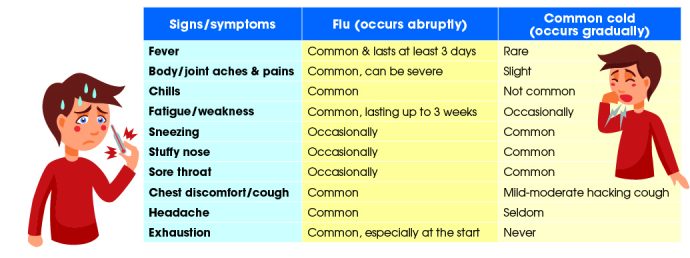The common cold is caused by hundreds of different viruses and many people often mistake it for influenza. In actual fact, influenza is highly contagious and is a potentially life-threatening disease.
Misinformation is your enemy, so learn as much as you can about influenza to be better prepared. Sadly, there are a lot of myths that we tend to believe:
Myth: The flu is nothing serious
While the flu is generally not considered a fatal disease for a healthy individual, it can cause severe complications, especially in infants, toddlers, young children and the elderly.
Myth: Antibiotics work for the common cold and flu
Viruses are typically the main cause for both, thus antibiotics are completely ineffective! Antibiotics only work against bacterial infections.
Myth: Vitamin C prevents the common cold and flu
Studies have not found evidence that directly supports this claim.
Myth: Healthy people don’t need the flu vaccination
Being healthy does not grant a person immunity from disease, so the annual vaccine still serves its purpose. Pregnant women can also opt for this at any stage of pregnancy as a means of protection.
Potential for disaster
Influenza is more than just a cough and a fever. Depending on where the virus strikes, it can cause serious complications such as sinusitis (sinus infections), bronchitis, pneumonia, meningitis/encephalitis, and even muscle inflammation. Infants and toddlers face the possibility of febrile convulsions and inflammation of the middle ear. Don’t underestimate the flu and take it lightly – it can also worsen existing conditions such as asthma, diabetes or heart disease.
Flu treatment usually involves antiviral drugs (NOT antibiotics!), but to gain its full benefits, these need to be taken within two days of falling ill. Starting antiviral medication later may help lessen the severity of symptoms, especially for those who face higher risks of serious flu complications or already suffer from a more severe illness. Typical side-effects include nausea, vomiting, runny nose, stuffy nose, cough, and/or diarrhoea.
Recognising the ‘enemy’
Another problem that many people face is the confusion of recognising whether it is flu or the common cold. Can you tell them apart? Here’s how:

Regardless of whether it is the flu or the common cold, seek medical attention immediately if your child develops a high fever above 39°C, and especially if the fever does not go down or keeps recurring.
How it spreads

Stopping influenza in its tracks
Take charge and do everything you can to prevent the flu from spreading. While there are no vaccines for the common cold, you can get a flu shot for influenza. Remember, you and your spouse may be strong enough to overcome influenza, but your child (and the older folks around you) may not. The most effective way is to get vaccinated every year. You can also limit the spread of the influenza virus by:
- Practising good hygiene. Wear a mask and wash hands with soap and water or use hand sanitiser. This helps minimise the direct transmission of the disease to/from you or your family members.
- Avoiding crowded places (especially during influenza season/outbreak) – reduce your exposure to any potential source of infection, i.e. people who have the flu. Going to public places also leaves you vulnerable to indirect transmission of influenza.
Why every year?
The influenza vaccine gets a yearly “update” based on the influenza strain that is most likely to be in circulation during that year. Don’t carry the virus home. Everyone deserves to be protected against influenza. Talk to your doctor to get the annual flu shot.
An educational contribution by Malaysian Paediatric Association.






Comments